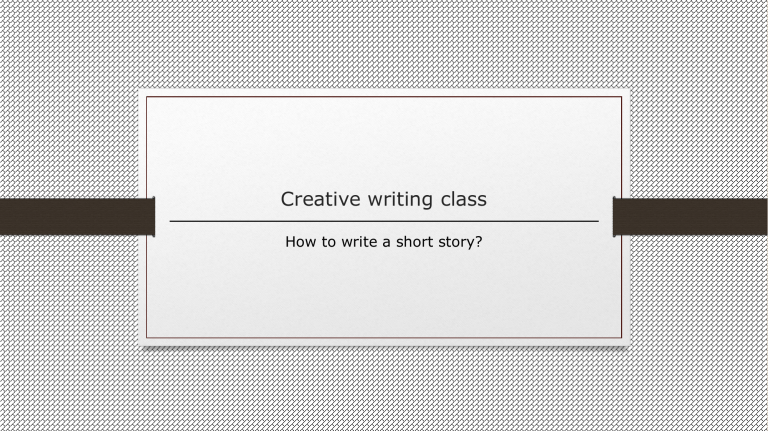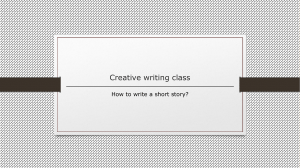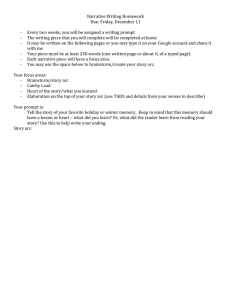
Creative writing class How to write a short story? Stories are everywhere Those who tell stories rule the world. Native American proverb Why do people read? Why is reading important? Why are stories important? Where do we hear stories? Where do we tell stories? Storyteller dice Structure of a story • Story arc (next slide) • Coca-cola commercial & Cinderella • 1. Exposition • 2. Conflict • 3. Rising action • 4. Climax • 5. Falling action • 6. Resolution Form: personal narrative or short story? • It is all about labelling • f.ex. a novel heavily based on personal experiences, but written in the third person and the names have been changed • f.ex. short story in the first person making it look like some sort of diary (or personal story), but it is entirely fictional. Choose your form! Form: personal narrative or short story? Choose your form: ideas Tell a true story from your own experience, but write it as if it were a fiction piece, with fictional characters, in third person. Create a completely fictional story, but tell it in first person, which would give it the same feel as a personal narrative. Tell a true story that happened to someone else, but write it in first person, as if you were that person. For example, I could write about my grandmother’s experience of getting lost as a child, but I might write it in her voice. More ideas? Assignment • Write a short story Min 1 page Max 2 pages Criteria: Verdana – 9 – line spacing 1,5 – fully aligned – title • How to? Throw the storytelling dice and pick 3 dice Use these three elements in your story (can be as a main storyline, side storyline, just mention it shortly, …) Think of a short story (beginning – middle – ending) Following the writing plan (next slide) Think of a good title The writing process • Determine your focus: what will your story be about? • Who is/are the protagonist(s)? Background? • What do you know about your protagonist(s)? (man/woman – age – name – appearance – characteristics - …) • What happens to your protagonist? (certain action – adventure - …) • What is the cause of main event? (cause – place – surroundings – setting - …) • Think of an ending (the resolution to your problem) • Determine your form. • Start making a draft (this involves a lot of scratching and starting again) • Write your story in the story arc template. Hand this in on time! • Use the feedback you get. EXAMPLE Title: “Frog” Main idea: a 13-year-old girl who finally gets to stay home alone, then finds a frog in her house and gets completely freaked out, which basically ruins the fun she was planning for the night. How to start writing? • Write your story. • Reread. • Reread again! (let somebody else read it as well) • Make sure your story has a beginning – middle – ending (you can use the story arc). • Use your spell check! • Give your story an appropriate title • Lay-out (Verdana – 9 – line spacing 1,5 – fully aligned) • Reread again (preferably not on your screen but on a printed out paper) • Check the evaluation criteria and the general checklist on Smartschool to see if you have done everything asked. • Hand in on time! Important information DEADLINES • Handing in of the story arc Thursday the 23rd or January • Hand in your story (on paper, put it in my personal box) Thursday the 5th of March EVALUATION CRITERIA • Smartschool (English > creative writing)


